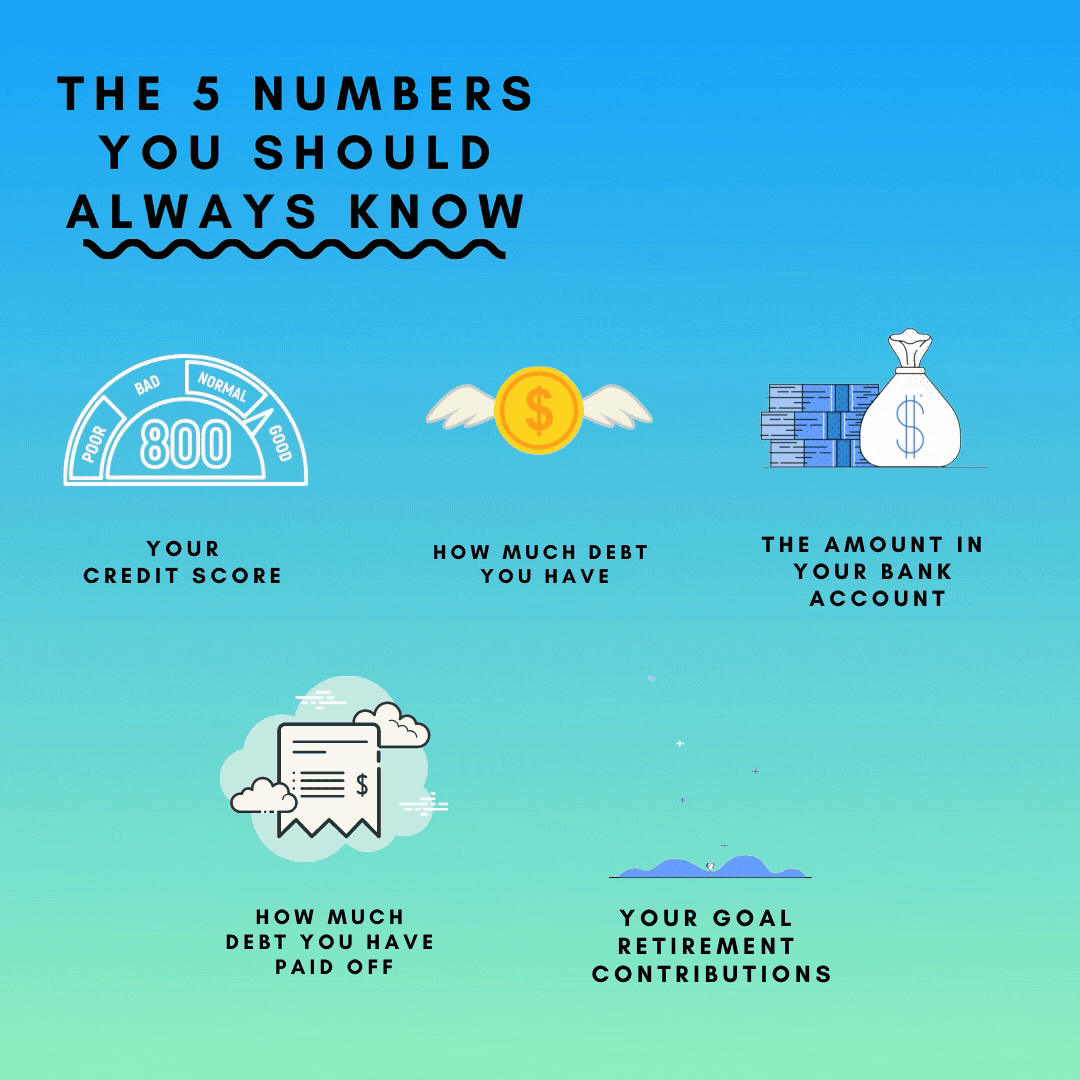
- Posted on
- Comments 0
5 Money Numbers you Should Always Know
By Rachel Sommer . February 22, 2021

1. Your Credit Score
Technically you have a few different credit scores, as different lenders and credit-scoring agencies have their own formulas for determining your score. However, the most important and commonly used are the FICO score and your VantageScore. Both models score you between 300 and 850, and the higher your score the better. Both also take similar factors into account, including the amount of debt you have relative to credit available and your payment history record. Knowing your credit score is important because this score determines if you can borrow, and at what rates. It’s also used by many other companies, like landlords when they’re deciding whether to rent to you, and by utility and cellphone companies. A good credit score shows you’ve generally been responsible with payments, aren’t maxed out on your credit cards, and have a good mix of available credit. A bad credit score suggests you have some work to do when it comes to managing your debt — and could also make it more difficult and expensive to borrow in the future. Plus, keeping track of both your credit score and credit report can help you stay on top of any potential identity theft issue
2. How much debt you have
Debt is like a shadow, you know it’s there but you don’t want to look at. It is important to face your financial fear so you can stay on top of your spending and reach your goals faster.
When estimating debt, American households estimated they owed around $440 billion in credit card debt in 2010, which is just 60% of the $731 billion lenders said was actually due, according to a 2015 study published in FRBNY Economic Policy Review.
When it comes to student loans, debtors were also off, with households estimating they owed only $578 billion instead of the true $778 billion. We know it’s scary, but you need to know your number so you can be realistic about setting financial goals. You don’t want to carry debt with you into retirement, for example, or have it carried over to your next-of-kin when you pass away; so find out how much you owe and how long it will take you to pay everything off. A debt repayment calculator can help you explore how accelerating payments could help you become debt free faster.
3. How much debt you have paid off

This one may seem counter-intuitive, I already paid off that pesky debt, why remind myself of it? Well there are a few reasons, It is empowering to see a physical number paid off and to keep track of how far you have come. It is also humbling and may make you rethink your spending or borrowing habits.
4. The number in your bank account
This one seems obvious but many people don’t check their bank account enough! This usually is from a fear state of mind but it’s better to face your fears than get hit with an overdraft charge. You can’t make good financial choices without knowledge, and you need to know where you stand. Creating wealth is all about staying on top of things, you have to have a plan to get to where you want and know how to take action to get there.
5. Your Goal Retirement Contributions

Most financial planning studies suggest that the ideal contribution percentage to save for retirement is between 15% and 20% of gross income. These contributions could be made into a 401(k) plan, 401(k) match received from an employer, IRA, Roth IRA, and/or taxable accounts. A good rule of thumb is to aim to save at least 1x your salary by 30, 3x by 40, 6x by 50, 8x by 60, and 10x by 67. However there are factors that will drastically impact your savings goals that you need to consider, such as the age you plan to retire and the lifestyle you plan to have in retirement. If you’re behind, don’t fret. There are ways to catch up. The key is to start now.
A good rule of thumb is to aim to save at least 1x your salary by 30, 3x by 40, 6x by 50, 8x by 60, and 10x by 67.
* Bonus Need-to-know number!* Interest rates
You would be surprised how many people not only don’t know what an interest rate is but also don’t know what their individual interest rates are.
When you take out a loan, whether it’s a car loan, home loan or credit card, you’ll have to pay back both the amount you borrowed and interest on top of it. But what do we mean by that? Well, essentially, interest is a fee you pay for using someone else’s (usually the bank’s) money. It’s how lenders make profit from giving out loans – after all, they’re not in this business out of the goodness of their hearts.
Usually the repayments you make on a loan will be made up of two parts: the part that reduces your balance to pay off your loan, and the part that covers the interest on the loan.
Calculating interest month-by-month is an essential skill. You often see interest rates quoted as an annualized percentage—either an annual percentage yield (APY) or an annual percentage rate (APR)—but it’s helpful to know exactly how much that adds up to in dollars and cents, as we commonly think in terms of monthly costs.
For example, you have monthly utility bills, food costs, or a car payment. Interest is also a monthly (if not daily) event, and those recurring interest calculations add up to big numbers over the course of a year. Whether you’re paying interest on a loan or earning interest in a savings account, knowing how much you actually pay for things is a big deal for your budget.
Liked this post? Keep up with all of the latest in tech news, computer security, money management, retirement planning, and more sent straight to your inbox by signing up for our newsletter!








